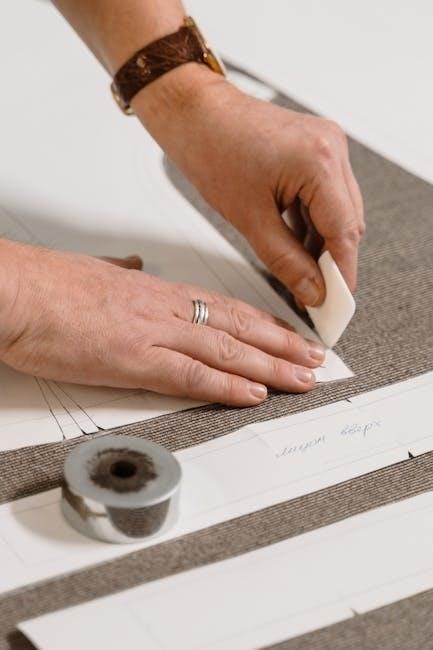This guide helps you find the perfect T-shirt fit, covering essential measurements, size charts, and fabric considerations to ensure confidence in your size selection. Comprehensive resource.
Importance of Proper Fit in T-Shirts
A proper fit in T-shirts ensures comfort, confidence, and a flattering appearance. Whether the shirt is too tight or too loose, it can compromise both style and functionality. Measurements like chest circumference, shoulder width, and sleeve length are critical to avoid discomfort or an unflattering look. The right fit enhances mobility and maintains the intended design, making it essential for everyday wear or special occasions. Proper sizing also prevents excessive fabric bunching or restrictive movement, ensuring a seamless experience.
How to Use This Guide Effectively
To use this guide effectively, start by understanding your body measurements and comparing them to the size charts provided. Lay the T-shirt flat and measure key dimensions like chest, shoulder width, and sleeve length using a flexible tape measure. Measure twice for accuracy and consider fabric type, as stretch and material can affect fit. Match your measurements to the size chart to find your ideal size, ensuring comfort and confidence in your choice.

Key Measurements for T-Shirt Sizing
Key measurements include chest circumference, shoulder width, sleeve length, and shirt length. Accurate measurements ensure a comfortable and flattering fit, considering fabric type and stretch.
Chest Measurement: The Most Critical Dimension
Chest measurement is the most important factor in determining T-shirt size. Measure around the fullest part of your chest, keeping the tape level and parallel to the floor. Ensure the tape isn’t too tight or loose. This measurement directly impacts how the shirt fits across your torso. For a comfortable fit, choose a size that aligns closely with your chest measurement, considering fabric stretch and desired fit style, whether slim, regular, or oversized.
Shoulder Width and Sleeve Length: Ensuring Comfort and Fit
Shoulder width and sleeve length are crucial for a comfortable fit. Measure shoulder width from the base of one shoulder to the other, keeping the tape level. Sleeve length is measured from the shoulder seam to the wrist. Accurate measurements ensure the shirt sits well on your frame, avoiding restrictive or overly loose sleeves. Proper fit in these areas enhances both comfort and the overall appearance of the T-shirt.
Understanding Different T-Shirt Fits
Explore various T-shirt fits, from slim to oversized, to discover which style suits your body type and personal preference for optimal comfort and aesthetics.
Slim Fit vs. Regular Fit: What’s the Difference?
Slim fit T-shirts are designed to hug the body closely, with narrower shoulders and chest measurements, while regular fit offers a looser, more relaxed silhouette. Slim fit is ideal for a modern, tailored look, while regular fit provides comfort and ease of movement. Chest measurements for slim fit are typically 1-2 inches smaller than regular fit, and shoulder widths are slightly narrower. Choose based on your lifestyle and body type for the best comfort and style.
Oversized Fit: When and How to Choose It
Oversized T-shirts offer a relaxed, loose silhouette, often longer in length and wider in chest and shoulders. Ideal for casual, trendy looks or layering, they provide maximum comfort. Choose oversized for a stylish, laid-back vibe or if you prefer a roomier fit. Measure 2-4 inches beyond your regular chest size for the best oversized look. Perfect for all body types seeking comfort and modern fashion appeal.

How to Measure a T-Shirt
Lay the T-shirt flat on a surface. Use a flexible tape measure at least 36 inches long. Measure each dimension twice for accuracy. Record the measurements to determine the perfect fit.
Measuring a T-Shirt While It’s Laid Flat
Lay the T-shirt flat on a smooth surface. Use a flexible tape measure at least 36 inches long. Measure the chest width, shoulder width, sleeve length, and shirt length. Ensure the garment is evenly spread and smooth out wrinkles. Record each measurement twice for accuracy. Compare these measurements to a size chart to determine the best fit. This method ensures precise sizing without distortion.
Measuring a T-Shirt While It’s Being Worn
Assess the fit by wearing the T-shirt and evaluating comfort. Measure chest circumference at the fullest point, ensuring the tape is level and not too tight. Check shoulder seams for proper alignment and sleeve length to your preference. Ensure the shirt length is appropriate for your torso. Measure while standing straight to get accurate dimensions. This method helps determine how the T-shirt fits on your body during natural movement.
How to Measure Your Body for the Perfect Fit
Take accurate body measurements using a flexible tape measure. Measure chest under armpits, shoulders from seam to seam, and note your posture for precise sizing.
Chest and Shoulder Measurements: The Basics
Measure your chest by wrapping a flexible tape measure under your armpits, around the fullest part of your chest. Ensure the tape is level and not too tight. For shoulders, measure from one seam to the other across the back. These measurements are crucial for determining your T-shirt size and ensuring a comfortable, well-fitting garment. Accurate posture during measurement is key to achieving the best fit.
Sleeve Length and Body Measurements: Getting It Right
Measure sleeve length from the shoulder seam to your wrist with your arm relaxed. For body length, measure from the highest shoulder point to your desired hem. Ensure the tape measure is straight and not twisted. Accurate sleeve and body measurements help determine the perfect fit, whether you prefer a regular or longer-style T-shirt. Proper alignment ensures comfort and a flattering silhouette.

T-Shirt Size Chart: A Comprehensive Guide
This chart provides detailed measurements for chest, shoulder, sleeve length, and body length across various sizes, ensuring accurate fit selection for both men’s and women’s T-shirts.
Men’s T-Shirt Size Chart: Understanding the Numbers
The men’s T-shirt size chart provides a detailed breakdown of measurements, including chest circumference, shoulder width, and shirt length. Sizes range from Small to XXL, with chest measurements typically varying from 34/36 inches (Small) to 46/48 inches (XXL). Shoulder width and shirt length increase proportionally with each size. Use the chart to match your body measurements to the closest size for a perfect fit. Always consider fabric stretch and personal comfort preferences when selecting your size.
Women’s T-Shirt Size Chart: Key Differences
The women’s T-shirt size chart differs from men’s, focusing on bust measurements and fit preferences. Sizes range from XS to XXL, with measurements tailored to women’s body proportions. Chest measurements are typically the primary factor, ranging from 32-34 inches (XS) to 46-48 inches (XXL). Shoulder and sleeve lengths are adjusted for a more feminine fit. The chart also accounts for varying styles, such as slim, regular, or relaxed fits, ensuring a tailored look for every body type.
How Fabric Type Affects Fit
Fabric type significantly influences T-shirt fit. Cotton offers breathability and natural drape, while polyester blends provide durability and structure. Blends combine softness with stretch, ensuring a tailored fit. Different fabrics stretch differently, impacting sizing accuracy and comfort, so fabric choice is crucial when selecting the perfect T-shirt size.
Cotton, Polyester, and Blends: What You Need to Know
Cotton is breathable and soft, ideal for casual wear, while polyester offers durability and shape retention. Blends combine the softness of cotton with polyester’s strength, offering a balanced fit. Cotton shirts may shrink slightly after washing, so pre-washing before measuring is recommended. Polyester and blends retain their shape better, reducing the need for resizing. Understanding fabric types helps in selecting the right size for a comfortable and flattering fit.
How Different Fabrics Can Change Your Size Choice
Fabric type significantly impacts fit and size selection. Natural fibers like cotton may shrink slightly, suggesting sizing up for comfort. Polyester and blends offer stretch, potentially allowing a size down. Lightweight fabrics drape differently, while heavier ones provide structure. Understanding your fabric’s properties ensures accurate measurements and the best fit. Always consider fabric type when choosing your size for optimal comfort and appearance.
Common Mistakes to Avoid When Measuring
Improper techniques, such as not using a flexible tape measure or ignoring fabric stretch, can lead to poor fit. Always measure carefully and consistently for accuracy.
Not Taking Body Measurements Seriously
Neglecting accurate body measurements can result in poor fit. Always measure chest, shoulders, and sleeves carefully, using a flexible tape measure. Avoid guessing sizes, as this often leads to discomfort or an unflattering appearance. Consistency is key; take measurements twice to ensure accuracy. Ignoring body type or fabric stretch can also cause sizing errors. Proper measurement ensures a flattering and comfortable fit for all T-shirt styles.
Ignoring Fabric Type and Stretch
Overlooking fabric type and its stretch can lead to a poor fit. Different fabrics, like cotton, polyester, or blends, have varying stretch levels. Cotton offers minimal stretch, while polyester blends provide more flexibility. Ignoring these factors can result in a T-shirt that is either too tight or too loose. Always consider fabric stretch when choosing a size to ensure comfort and proper fit. This step is crucial for achieving the desired look and feel.

Tips for the Perfect Fit
Ensure a perfect fit by measuring accurately, choosing sizes that match your body type, and considering fabric stretch for ultimate comfort and style.
How to Choose the Right Size for Your Body Type
Match your measurements to the size chart, considering your body type. For slimmer builds, opt for slim-fit tees, while broader shoulders may prefer regular or oversized styles. Measure your chest, shoulders, and sleeve length accurately. If your measurements fall between sizes, choose the next larger size. Consider fabric stretch for comfort. Ensure the fit allows movement without being too loose or tight for your desired look.
Considering the Stretch of the Fabric
Fabric stretch plays a crucial role in achieving the perfect fit. Cotton offers breathability but may shrink slightly, while polyester blends provide enhanced stretch for comfort. Measure garments while they’re flat to account for potential shrinkage. Choose a size that allows for your desired level of tightness, ensuring the fabric has enough give for movement. This ensures comfort and maintains the intended look of the T-shirt.
How to Use This Guide to Buy the Right T-Shirt
Use this guide to match your measurements with size charts, consider fabric stretch, and ensure a proper fit for comfort and style.
Matching Your Measurements to the Size Chart
Match your body measurements to the size chart by comparing chest, shoulder, and sleeve length. Ensure accuracy by measuring twice and allowing 1-3cm for manual errors. If between sizes, choose the next larger one. This method guarantees a comfortable, well-fitting T-shirt. Use the chart to align your measurements with the closest size, considering fabric stretch and desired fit style.
Trying Before Buying: When Possible
Trying a T-shirt before purchasing ensures the best fit and comfort. Visit a store to test sizes, especially if the fit is critical. If unavailable, use your measurements and size guides to make an informed choice. Double-check your measurements to avoid returns. This step ensures confidence in your selection, whether shopping in-store or online, and helps you find the perfect T-shirt for your needs.
Mastering T-shirt measurements ensures a perfect fit and confidence in your purchase. By following this guide, you can make informed choices and enjoy your ideal T-shirt fit.
Final Thoughts on Achieving the Perfect Fit
Achieving the perfect T-shirt fit requires attention to detail and understanding your measurements. Consistently measure your body and compare with size charts to ensure accuracy. Consider fabric type, as stretch and material thickness impact fit. Balance style preferences with comfort, and don’t hesitate to try sizes if unsure. By following these guidelines, you’ll confidently select T-shirts that flatter your body and meet your personal style needs.